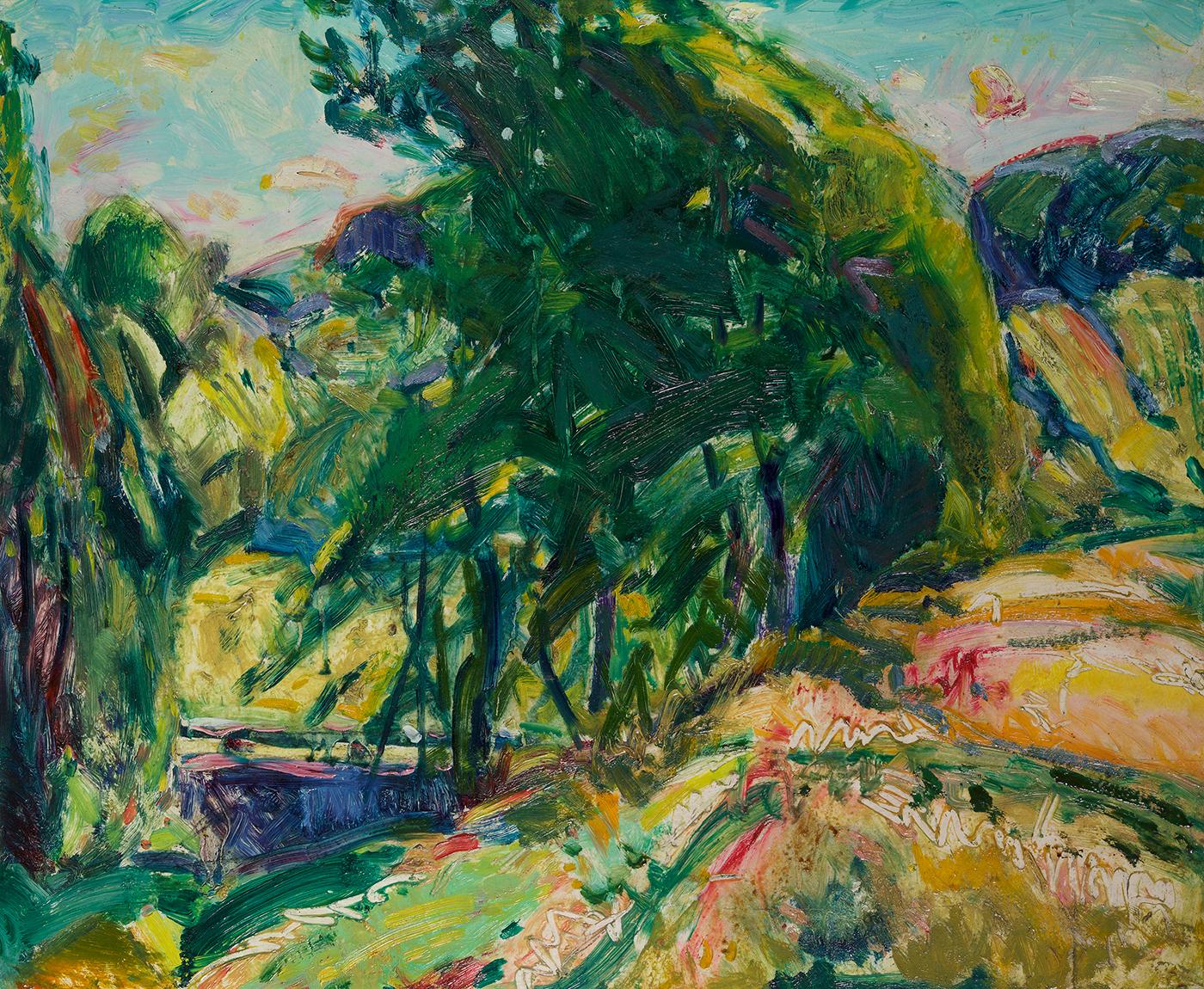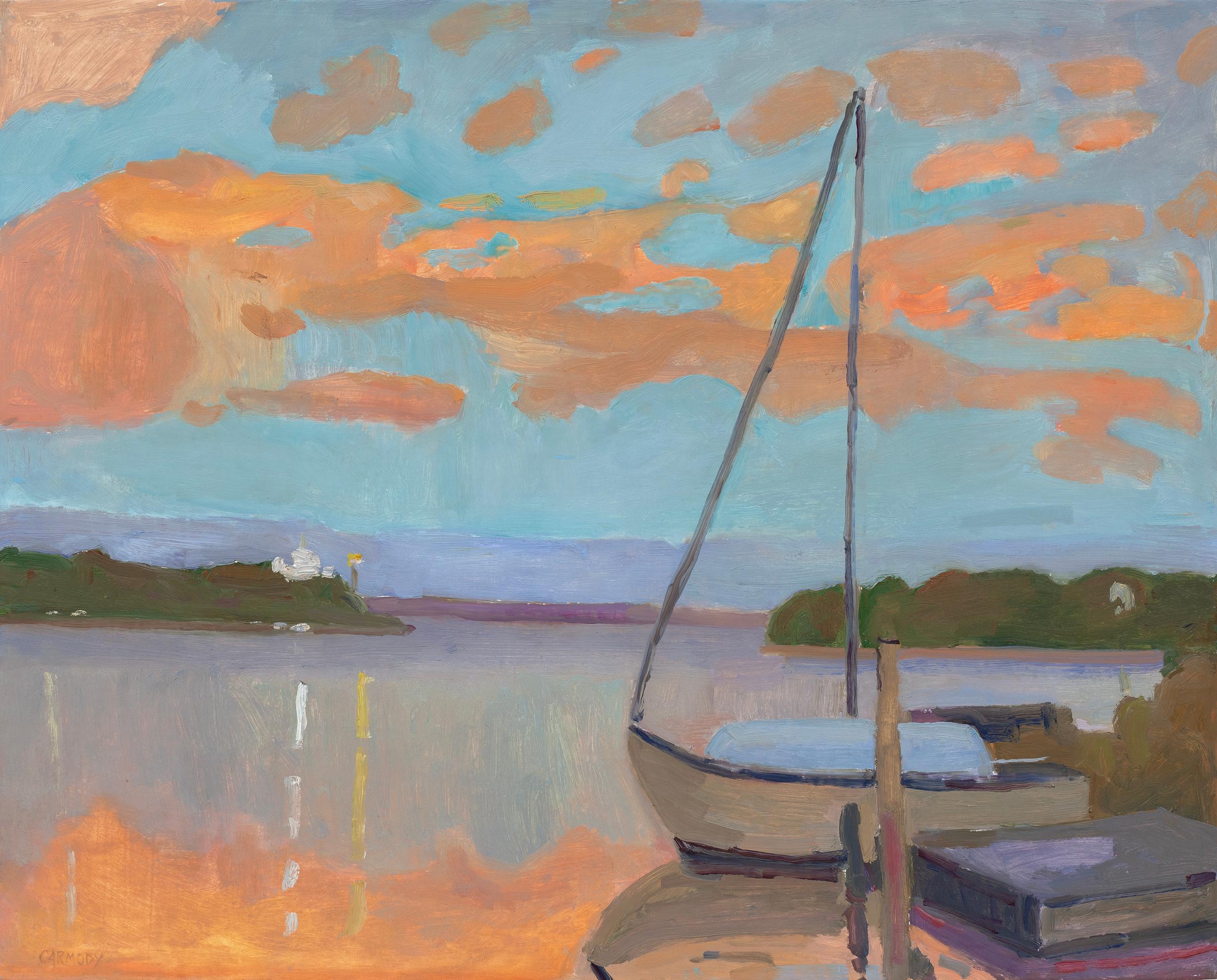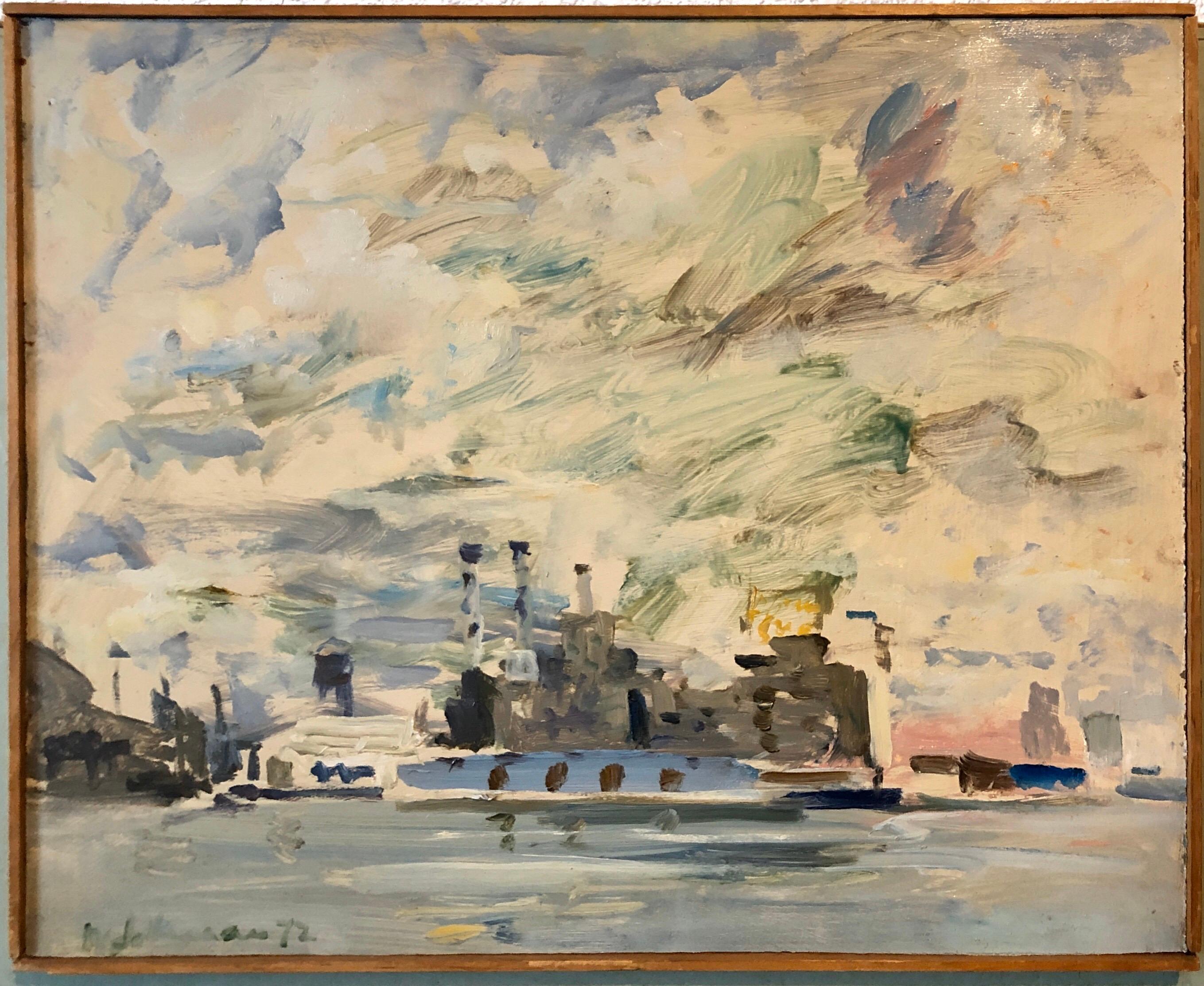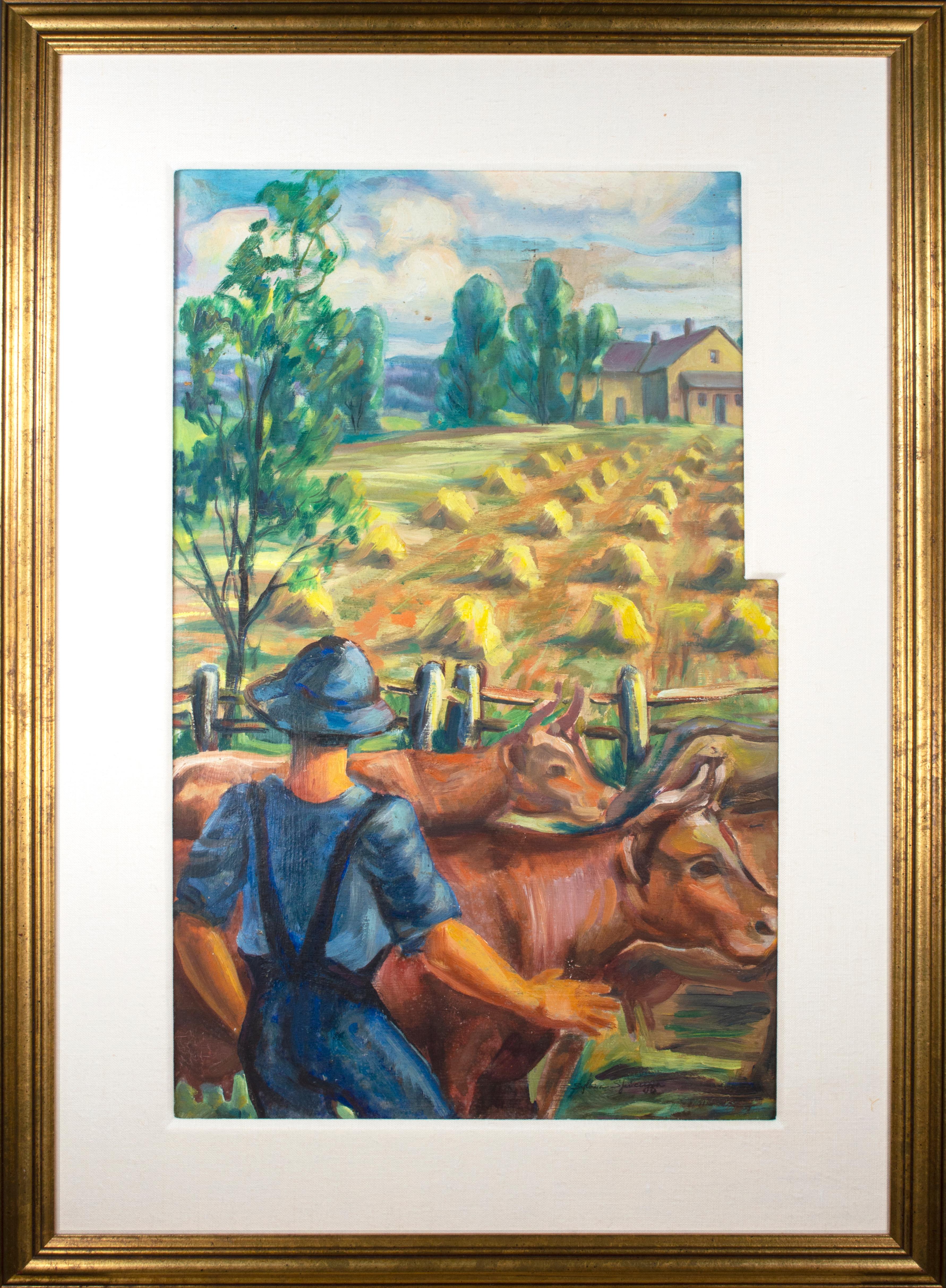Leon Dolice"Rainy Day, New York City" Modernist Urban Cityscape Mid-Century Street Scenecirca 1940
circa 1940
About the Item
- Creator:Leon Dolice (1892 - 1960, American, Austrian)
- Creation Year:circa 1940
- Dimensions:Height: 24 in (60.96 cm)Width: 20 in (50.8 cm)
- Medium:
- Movement & Style:
- Period:
- Condition:Excellent.
- Gallery Location:New York, NY
- Reference Number:1stDibs: LU184129907362
Leon Dolice
Leon Dolice, born in Vienna on August 14, 1892, even as a young boy, preferred the lure of painting to the scholastic studies which his early years had expected of him. His father was a machinist, which exposed the boy to welding and metal crafts. However, his interest in art led him to abandon a secure future in the family business, and he spent most of his late teens and early 20s traveling through the capital cities of Europe studying the works of the masters. As with many itinerant artists, he made his way in a variety of fashions metalworker, chef, designer somehow always managing to give vent to his creative instincts. Lured by the adventure of crossing the great Atlantic and by the freedoms of the New World, he came to America in 1920. There, he was greeted by the turbulence of New York in the Roaring 20s. Finding a retreat in the European Bohemianism of Greenwich Village, he picked the streets of this landmark neighborhood as his first subjects. With the encouragement of new-found friends and artists such as George Luks and Herb Roth, he soon ventured out and devoted all his time to chronicling the architecture, back streets, dock scenes and other nostalgia that was fast disappearing from the face of Manhattan, mainly in copperplate etchings. A favorite subject for him was the Third Avenue El near one of his New York City studios on Third Avenue. He won accolades for his work, and although he traveled the East Coast recording landmarks in other cities including Washington DC, Baltimore, Chicago and Philadelphia, he always returned to his new home Manhattan. A decline in popular favor for etchings led him to put aside his plates in the late 1930s and devote some 10 years to pastels, linocuts and painting. His subject matter was almost exclusively New York City street scenes, but figurative works, country scenes and even experiments with Abstract Expressionism at the height of its new-found favor in the 1940s punctuated his career. In 1953, after learning of the forthcoming demise of the Third Avenue El, in the shadow of which he had maintained his studio for over a decade, he once again took to his plates and press and created a final series of Third Avenue and or other New York City landmarks that were then threatened with extinction. His work brings to light aspects of nostalgic New York that survives today only in small part, whether in architecture or spirit. Dolce's works are in several notable museums and private collections, including the Museum of the City of New York; the Print Collection of The New York Public Library; The New-York Historical Society; the Georgetown University Library; The Philadelphia Print Club and others. In the past few years, his work has been exhibited at Hofstra University Museum of Art, Long Island, New York; with the Montauk Artists' Association, Montauk, New York and at the Tribeca Gallery, New York City. An exhibition of his works on paper was held from February 28 to March 14, 2003, at the Belleclaire Hotel at 250 West 77th Street and Broadway in New York City. Featuring historic street and landmark scenes of New York City created from 1920 through 1952, it was held as a tribute to New York, which had been sharply in the world's focus following the events of the previous six months.
- ShippingRetrieving quote...Ships From: Larchmont, NY
- Return PolicyA return for this item may be initiated within 3 days of delivery.
- "Snow at Madison Square Park, " Bela de Tirefort, New York Snow Street SceneBy Bela de TirefortLocated in New York, NYBela de Tirefort (1894 – 1993) Snow at Madison Square Park, 1951 Oil on canvasboard 16 x 20 inches Signed and dated lower left; signed and titled on the reverse on artist label Prov...Category
1950s American Modern Landscape Paintings
MaterialsBoard, Oil
- "New York City Harbor, " Modernist View of Port and Boats on a Cloudy DayBy Bela de TirefortLocated in New York, NYBela De Tirefort (1894 - 1993) New York City Harbor, 1932 Oil on canvasboard 14 x 18 Signed and dated lower left: De Tirefort 32 Bela de Tirefort was born in Eastern Europe, painted...Category
1930s American Modern Landscape Paintings
MaterialsBoard, Oil, Canvas
- "Winter Landscape, Central Park, New York City, " Snowy December ChristmasBy Bela de TirefortLocated in New York, NYBela De Tirefort (1894 - 1993) Winter Landscape, Central Park, New York City, 1934 Oil on board 12 x 17 1/2 inches Signed and dated lower left: De Tirefort 34 Bela de Tirefort was b...Category
1930s American Modern Landscape Paintings
MaterialsBoard, Oil
- "Bucolic Landscape, " Sally Michel Avery, Female American Modernist Bright PastelBy Sally Michel-AveryLocated in New York, NYSally Michel Avery (1902 - 2003) Bucolic Landscape with Cows, 1963 Oil on canvasboard 9 x 12 inches Signed and dated lower left Provenance: The art...Category
1980s American Modern Landscape Paintings
MaterialsBoard, Oil, Canvas
- "Tree, Trunk, and Roots, New York" Joseph Stella, American ModernismBy Joseph StellaLocated in New York, NYJoseph Stella (1877 - 1946) Tree, Trunk, and Roots, Bronx, New York, circa 1924 Oil on canvas 12 x 16 inches inscribed in another hand Joseph Stella/Estate and bears Joseph Stella Estate stamp (on the reverse) Provenance: The Estate of the Artist Rabin & Kreuger, New Jersey Parke Bernet Galleries, New York, March 14, 1968, Lot 147 ACA Galleries, New York Thence by descent Stella was born June 13, 1877 at Muro Lucano, Italy, a mountain village not far from Naples. He became painter laureate of Muro Lucano when he was in his teens with a representation of the local saint in the village church. Stella immigrated to America in 1896 and studied medicine and pharmacology, but upon the advice of artist friend Carlo de Fornaro, who recognized his undeveloped talent, he enrolled at the Art Students League in 1897. Stella objected to the rule forbidding the painting of flowers, an indication of his lifelong devotion to flower painting. He also studied under William Merritt Chase in the New York School of Art and at Shinnecock Hills, Long Island in 1901-1902, displaying the bravura brushwork and dark Impressionist influence of Chase. Stella liked to paint the raw street life of immigrant society, rendering this element more emotionally than the city realists, the Aschcan School headed by Robert Henri. Stella went through a progression of styles--from realism to abstraction--mixing media and painting simultaneously in different manners, reviving styles and subjects years later. The "Survey" sent Stella to illustrate the mining disaster of 1907 in Monongah, West Virginia, and in 1908 commissioned him to execute drawings of the Pittsburgh industrial scene. Steel and electricity became a major experience in shaping his responses to the modern world, and Stella succeeded in portraying the pathos of the steelworkers and the Pittsburgh landscape. Stella went abroad in 1909 at the age of thirty-two, lonely for his native land. He returned to Italy, traveling to Venice, Florence and Rome. He took up the glazing technique of the old Venetian masters to get warmth, transparency, and depth of color. One of Stella's paintings was shown in the International Exhibition in Rome in 1910 and was acquired by the city of Rome. The influence of the French Modernists awakened his dormant individuality. His friendship with Antonio Mancini, a Futurist, also played a role in his new style. At the urging of Walter Pach...Category
1920s American Modern Landscape Paintings
MaterialsCanvas, Oil
- "Colorado Landscape, " Western Precisionist Regionalism American Scene PaintingBy William SandersonLocated in New York, NYReminiscent of an Edward Hopper or Andrew Wyeth scene, or even Charles Demuth with its cubist elements. William Sanderson (1905 - 1990) Colorado Landscape Oil on canvas 23 1/2 x 31 1/2 inches Signed lower right: Sanderson Born in Dubbeln, near Riga, Latvia in 1905, his personal journey from Czarist Russia, to New York City, and finally to Colorado, is one of remarkable courage and perseverance. Sanderson exhibited in numerous solo and group exhibitions throughout Colorado and the West between 1945 and 1985, and he was voted one of Colorado's influential artists of the 20th Century. Sanderson's paintings are represented in many museums and are sought after by collectors who appreciate his composition and precise use of color. The year 2005 marked the Centennial of Sanderson's birth, and he is now recognized as a major contributor to the development of modern art in Colorado. As a student at the National Academy of Design in 1927, Sanderson exemplifies an individual dedicated to creativity and the life-long passion for art. Known primarily as a Colorado artist, Sanderson first developed his skills as a graphic illustrator in New York City, and his work has appeared in numerous magazines, including New Yorker and New Masses. Notable book illustrations include The Jumping Off Place - 1929, by Marion Hurd McNeely, Jews Without Money - 1930, by Michael Gold...Category
Mid-20th Century American Modern Landscape Paintings
MaterialsCanvas, Oil
- Landscape with Green TreeBy Alfred Henry MaurerLocated in New York, NYAlfred Henry Maurer has been called the First American Modern because of his role in bringing modern methods of working to the United StatesCategory
Early 20th Century American Modern Landscape Paintings
MaterialsOil, Board
- "Orange Clouds" American contemporary seascape with sailboat, eveningBy Kelly CarmodyLocated in Sag Harbor, NY"Orange Clouds" is an American Modern contemporary seascape with sailboat, evening. Kelly Carmody’s work has been widely exhibited and collec...Category
21st Century and Contemporary American Modern Landscape Paintings
MaterialsOil, Panel, Wood Panel, Board
- "The Lone Boat" contemporary seascape and sailboat with green and blue tonesBy Kelly CarmodyLocated in Sag Harbor, NY"The Lone Boat" is a contemporary seascape and sailboat with green and blue tones. Kelly Carmody’s work has been widely exhibited and collected. One of her major figurative works wa...Category
21st Century and Contemporary American Modern Landscape Paintings
MaterialsPanel, Oil, Wood Panel, Board
- "Looking Out" contemporary seascape with young woman in whiteBy Kelly CarmodyLocated in Sag Harbor, NY"Looking Out" is a contemporary seascape with a young woman in white admiring the view. Framed dimensions: 14 x 24 inches Kelly Carmody’s work has been widely exhibited and collect...Category
21st Century and Contemporary American Modern Figurative Paintings
MaterialsOil, Panel, Board, Linen
- 1972 Gestural Oil Painting Boat in Harbor Figural Abstraction Raoul MiddlemanBy Raoul MiddlemanLocated in Surfside, FLRaoul Middleman (born 1935 in Baltimore, Maryland) is an American painter. Middleman has been a member of the Maryland Institute College of Art faculty since 1961. American University Museum at the Katzen Center has described Middleman as a "Baltimore maestro [whose] nudes are not pretty—they are sagging, dimpled, and real. His cityscapes reveal the underbelly of post-industrial rot, his narrative paintings give contemporary life to his personal obsessions. They are intelligent, messy, and utterly masterful." From an interview with RM "I was doing abstract art. Then Roy Lichtenstein came around, and I wanted to be current. I remember Grace Hartigan said, “You’ve gotta go to New York, seize destiny by the hand.” My friend Jon Schueler took my slides up to Eleanor Ward, who had the Stable Gallery. My Pop art paintings were discovered. I moved to New York into Malcolm Morley’s old loft down on South Street. Agnes Martin was upstairs... People who interest me come from different quarters. I knew guys around Schueler, like B.H. Friedman. But I also knew the Pop world pretty well – Al Hansen, Richard Artschwager, Lichtenstein. I became friends with Raoul Hague and I rented a place in Port Jervis, New York. I started doing my first landscapes up there. I thought making landscapes was the dumbest thing you could do. You got flies, insects, cow pies, humidity. But I loved it... I went down to the meetings of the Figurative Alliance. I met my friends there — Paul Resika, Paul Georges, Rosemarie Beck...Category
1970s American Modern Landscape Paintings
MaterialsOil, Board
- 20th century figurative landscape oil painting pastoral scene farm field cowBy Sylvia SpicuzzaLocated in Milwaukee, WIThis early work by American artist Sylvia Spicuzza is an excellent example of Regionalism: in the foreground, a farmer in blue stands before a herd of cattle. Beyond the fence of the...Category
1930s American Modern Figurative Paintings
MaterialsOil, Board






